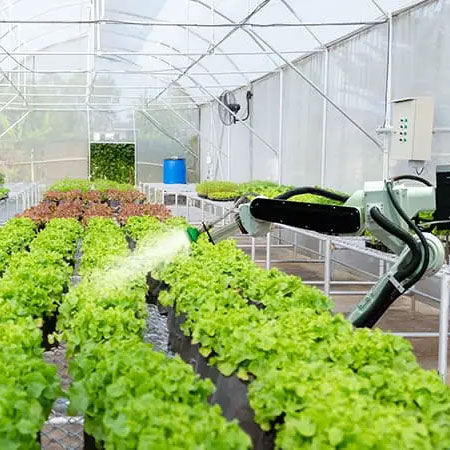- Soil moisture sensor becomes the "smart manager" for precise irrigation:
- Flow meters play an important role in water resource management:
- Water quality monitoring instruments safeguard crop growth:
- Meteorological instruments provide scientific basis for irrigation decisions:
- Pressure sensors ensure stable operation of irrigation systems:
It is an Application case of instruments in agricultural irrigation field of An oasis agricultural park in an arid region, with 2000 acres of arable land, mainly planted with economic crops such as grapes and red dates.
In the past, the agricultural park used traditional flood irrigation methods, which not only caused serious water resource waste, but also resulted in uneven crop yield and quality due to uneven irrigation, and the problem of soil salinization in some areas became increasingly prominent.

To change this situation, the agricultural park has introduced advanced agricultural irrigation instrument systems, opening a new chapter in smart irrigation.
Soil moisture sensor becomes the “smart manager” for precise irrigation:
The agricultural park has densely deployed hundreds of time-domain reflectance (TDR) soil moisture sensors in different plots and crop root layers. These sensors collect soil moisture data every 15 minutes and upload it in real-time to the central control system.
The system automatically determines whether irrigation is needed and the amount of irrigation water based on the water demand patterns of crops at different growth stages.
For example, during the swelling period of grape growth, when the sensor detects that the soil moisture content has dropped to 60% of the field capacity, the system immediately starts the drip irrigation system to accurately replenish water;
When it reaches 75%, irrigation will automatically stop. Compared to traditional irrigation, the application of soil moisture sensors has achieved a water saving rate of up to 40% in the park, significantly improved grape fruit plumpness and sugar content, and increased yield by 25%.
Flow meters play an important role in water resource management:
The agricultural park has installed electromagnetic and ultrasonic flow meters in the main and branch canals to monitor the water flow and total amount in each area in real time.
Managers can have a clear understanding of water usage in various regions through a data analysis platform, and scientifically allocate water resources based on crop planting structure and growth needs.
At the same time, once abnormal fluctuations in flow are detected in a certain area, such as sustained high flow at night, the system will automatically warn, and staff can quickly investigate and repair pipeline leaks to avoid hidden waste of water resources.
Water quality monitoring instruments safeguard crop growth:
The park is equipped with pH meters, conductivity meters, and turbidity meters for real-time monitoring of irrigation water sources.
In the jujube planting area, due to the high salinity of the local groundwater, pH meters and conductivity meters continuously monitor the acidity, alkalinity, and salt content of the soil and irrigation water.
When an increase in soil salinity concentration is detected, the system automatically adjusts the irrigation strategy and uses freshwater leaching to reduce soil salinity;
The turbidity meter effectively prevents the problem of clogging of drip irrigation system due to high sediment content in irrigation water, ensuring the stable operation of the irrigation system.
Meteorological instruments provide scientific basis for irrigation decisions:
The agricultural park has set up a small meteorological station, integrating equipment such as anemometers, thermometers, hygrometers, and solar radiation meters.
The meteorological station collects real-time data on wind speed, temperature, air humidity, and light intensity, and combines it with soil moisture sensors and crop water demand models.
In hot, dry, and windy weather during summer, the system automatically increases irrigation frequency based on meteorological data;
When encountering rainy weather, the meteorological station automatically suspends irrigation when the rainfall reaches a certain value, avoiding water waste and damage to crop roots caused by waterlogging.
Pressure sensors ensure stable operation of irrigation systems:
Pressure sensors are installed on both the main and branch pipelines of sprinkler and drip irrigation systems. These sensors monitor pipeline pressure in real-time and immediately sound an alarm once the pressure exceeds the set range.
For example, when a certain section of drip irrigation pipeline is blocked and the pressure rises, the pressure sensor quickly feedbacks, and the staff can clean up the blockage in a timely manner to prevent the pipeline from bursting;
At the same time, the system can automatically adjust the speed of the water pump based on pressure data, reducing energy consumption while ensuring irrigation effectiveness, and saving about 15% of electricity bills annually.
After a year of practical application, the Oasis Agricultural Park has achieved efficient utilization of water resources, increased crop yields and income, and improved soil environment through the comprehensive use of agricultural irrigation instrument systems.
Not only does it save more than 40% water, but it also increases the average crop yield by 20% -30%, and the fruit quality meets high-quality standards, greatly enhancing the competitiveness of the product in the market.
This case fully demonstrates that the scientific application of instruments in the field of agricultural irrigation is an effective way to promote the development of modern agriculture towards precision, intelligence, and sustainability.
